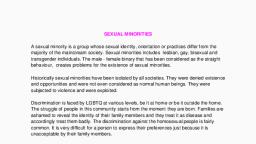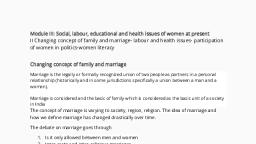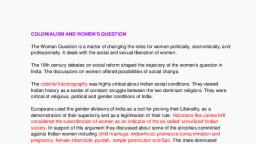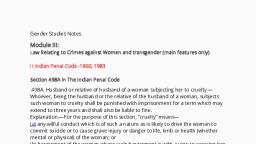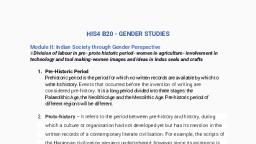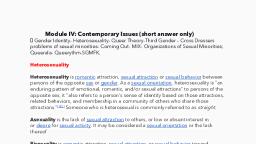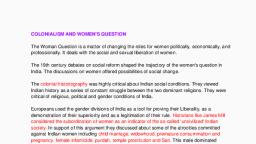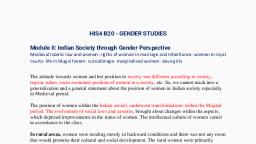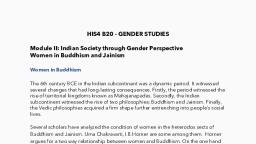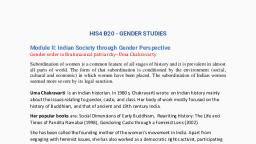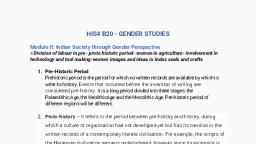Page 1 :
Gender Studies Notes, , Module III:, Law Relating to Crimes against Women and transgender (main features only), Indian Penal Code -1860, 1983, Section 498A in The Indian Penal Code, 498A. Husband or relative of husband of a woman subjecting her to cruelty —, Whoever, being the husband or the relative of the husband of a woman, subjects, such woman to cruelty shall be punished with imprisonment for a term which may, extend to three years and shall also be liable to fine., Explanation.—For the purpose of this section, “cruelty” means—, (a) any wilful conduct which is of such a nature as is likely to drive the woman to, commit suicide or to cause grave injury or danger to life, limb or health (whether, mental or physical) of the woman; or, (b) harassment of the woman where such harassment is with a view to coercing her, or any person related to her to meet any unlawful demand for any property or, valuable security or is on account of failure by her or any person related to her to, meet such demand.], Dowry Prohibition Act,1961, Dowry Prohibition Act, Indian law, enacted on May 1, 1961, intended to prevent the, giving or receiving of a dowry. Under the Dowry Prohibition Act, dowry includes, property, goods, or money given by either party to the marriage, by the parents of, either party, or by anyone else in connection with the marriage. The Dowry, Prohibition Act applies to persons of all religions in India., The original text of the Dowry Prohibition Act was widely judged to be ineffective in, curbing the practice of dowry. Moreover, specific forms of violence against women, continued to be linked to a failure to meet dowry demands. As a result, the, legislation underwent subsequent amendment. In 1984, for example, it was, changed to specify that presents given to a bride or a groom at the time of a, wedding are allowed. The law required, however, that a list be maintained, describing each gift, its value, the identity of the person giving it, and the person’s, relation to either party to the marriage. The act and relevant sections of the Indian, Penal Code were further amended to protect female victims of dowry-related
Page 2 :
violence. Another layer of legal protection was provided in 2005 under the, Protection of Women from Domestic Violence Act., Amendments to the original Dowry Prohibition Act also established minimum and, maximum punishments for giving and receiving dowry and created a penalty for, demanding dowry or advertising offers of money or property in connection with a, marriage. The Indian Penal Code was also modified in 1983 to establish specific, crimes of dowry-related cruelty, dowry death, and abetment of suicide. These, enactments punished violence against women by their husbands or their relatives, when proof of dowry demands or dowry harassment could be shown., Section 304B was added to the Indian Penal code in the year 1986, 304B. Dowry death., (1) Where the death of a woman is caused by any burns or bodily injury or occurs, otherwise than under normal circumstances within seven years of her marriage, and it is shown that soon before her death she was subjected to cruelty or harassment by her husband or any relative of her husband for, or in connection with,, any demand for dowry, such death shall be called “dowry death”, and such husband, or relative shall be deemed to have caused her death. Explanation. For the purpose, of this sub-section, “dowry” shall have the same meaning as in section 2 of the, Dowry Prohibition Act, 1961 (28 of 1961)., (2) Whoever commits dowry death shall be punished with imprisonment for a term, which shall not be less than seven years but which may extend to imprisonment for, life.], Protection of Women from Domestic Violence Act, 2005, Protection of Women from Domestic Violence Act 2005 is a major bill passed by the, Indian Parliament during the UPA1 government regime (2005)., The law is crucial, as it helps in the protection of women from the violence, she, faces in the place she lives in., Salient features of Protection of Women from Domestic Violence Act 2005, •, , Includes physical and mental ill-treatment.
Page 3 :
•, •, •, •, •, •, •, , Primarily meant for the protection of wife or female live-in partners., Law also extends to sisters, widows, or mothers., Harassment in the form of dowry demands also included in this law., Gives women the right to secure housing., The court can also issue protection orders that prevent the abuser to, harass the women by acts at her workplace., The act proposes the appointment of protection officers and NGOs., A breach of a protection order is a non-bailable offense., , CRITICISMS OF PROTECTION OF WOMEN FROM DOMESTIC VIOLENCE ACT 2005, •, •, •, , Abused men not covered; this law is specifically for women., Violence against women is often perpetrated by women herself – Eg:, Mother-in-law/ Daughter-in-law., Verbal abuse and mental harassment are subjective terms., , Indecent Representation of Women [Prohibition]Act,1986, Women’s organizations have agitated over the last decade with regard to how their, gender is being portrayed by the media. Women’s struggles with the portrayal of, advertisements that encourage parents to save dowries for the child; the equation, of a ‘good’ lady with a wife; a vegetable oil brand that equates to motherhood. It is, true that the number of advertisements promoting dowry has decreased due to, unrest among women’s organizations. But such campaigns have little impact on, advertisements promoting sexist stereotypes and pornographic images which have, increased if anything., Keeping the Indian social structure as in mind, the law aims to regulate women’s, portrayals in the different sections of Indian mass media today. In dealing with, society as diverse from a cultural point of view, the feelings of the community must, be given special attention and the State must also be protected. Morality remains a, very subjective issue in India and reflects a wide range of culturally and historicallychanging values and attitudes., It is also too complicated since there is no proof of how many women beneath, creamy and non-creamy layers of the economy are engaged in such indecent, treatment, to establish and examine cause and consequences. Similarly, it is, difficult to view the cause-and-effect relationship from a societal viewpoint, but it, can be understood from the impacts illustrated in various media that this kind of
Page 4 :
disgraceful portrayal of women leads to a societal environment deterioration in the, form of ever-greater crime and abuse against the individual. To put an end to this, crime, the Central Government enacted the law- Indecent Representation of, Women Act, 1986 which prohibits the obscene and indecent representation of, women and penalises them for committing such offences., , History of the legislation, The introduction of the Rajya Sabha Bill against Women’s Indecent Representation, in 1986 was in response to a women’s movement which called for a legislative, action against the negative depiction of women in the country. The bill was, introduced by Margaret Alva in the Rajya Sabha and became law in October 1987 by, way of enactment., The legislation intended to regulate women’s and representation in mainstream, media, especially in print. It was implemented to ensure that women’s, representation in the media was not indecent through ads, magazines,, publications, and illustrations., , Objective of the Act, The law on obscenity is codified in sections in this country-The Indian Penal, Code Section 292, Section 293 and Section 294. Despite these provisions, in, publications, especially in advertisements, there is a growing indecent, representation of women or references to women, which has the effect to, denigrate women but is also derogative of women. While there may be no specific, intention, these advertisements, publications, etc. have a depraving or corrupting, effect. A different legislation is, therefore, necessary to prevent the indeterminate, representation of women effectively by means of advertisements, books,, pamphlets etc., , Defining “indecency”, In Section 2(c) under the Indecent Representation of Women Act, 1986, the term, “indecent representation” is defined as meaning “indecent representation of, women” in any way to have the effect of being indignant or derogative of a woman,, or of being corrupt or of being susceptible to public morality, or moralistic
Page 5 :
depravity. The word “indecent representation” is defined in the 1986 law, with, emphasis on “depriving or corrupting” content, and this is confused with morality., In the 1970s and 1980s, women’s organizations protested the indecent portraiture, of women primarily focused on nudity and sexually provocative or overtly typical, portrayal of women and thus strengthened the belief that the expression of, sexuality, in particular the expression of a woman, is an obscenity., •, , The action was made in connection with the portrayal of the nude image, of the former player Boris Becker, and of his fiancée at Sportsworld,, released by the corporation in May 1993, against the editor of, Anandabazar Patrika, Aveek Sarkar, and the publisher at a court of law in, Kolkata. In Individual Female Représentation Cases, a 46.50% decrease, has been recorded, from 2,917 in 2005 to 1,562 in 2006, according to, the National Crime Records Bureau., , •, , In April 2006, a Madurai court issued non-bailable warrants in, photographs published by a Tamil newspaper against Reema Sen and, Shilpa Shetty for posing in an obscene manner. The study claimed that, for, the same reason, the two actresses had failed to comply with earlier, summons, thus issuing the warrants. The petitioner submitted that in its, issues of December 2005 and January 2006, the paper had published “very, sexy blow-ups and medium blow-ups” and allegedly infringed the Obscene, Representation of Women (Prohibition) Act 1986, Young Persons (Harmful, Publications) Act 1956, and the Indian Penal Code Section 292. The, plaintiff further demanded confiscation of the photographs under the, terms of the Press and Registration of Book Act 1867.





